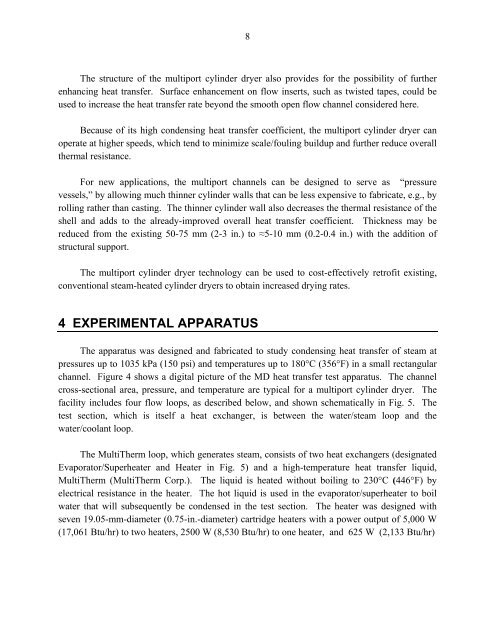final report on the multiport dryer - Argonne National Laboratory
final report on the multiport dryer - Argonne National Laboratory
final report on the multiport dryer - Argonne National Laboratory
Create successful ePaper yourself
Turn your PDF publications into a flip-book with our unique Google optimized e-Paper software.
8The structure of <strong>the</strong> <strong>multiport</strong> cylinder <strong>dryer</strong> also provides for <strong>the</strong> possibility of fur<strong>the</strong>renhancing heat transfer. Surface enhancement <strong>on</strong> flow inserts, such as twisted tapes, could beused to increase <strong>the</strong> heat transfer rate bey<strong>on</strong>d <strong>the</strong> smooth open flow channel c<strong>on</strong>sidered here.Because of its high c<strong>on</strong>densing heat transfer coefficient, <strong>the</strong> <strong>multiport</strong> cylinder <strong>dryer</strong> canoperate at higher speeds, which tend to minimize scale/fouling buildup and fur<strong>the</strong>r reduce overall<strong>the</strong>rmal resistance.For new applicati<strong>on</strong>s, <strong>the</strong> <strong>multiport</strong> channels can be designed to serve as “pressurevessels,” by allowing much thinner cylinder walls that can be less expensive to fabricate, e.g., byrolling ra<strong>the</strong>r than casting. The thinner cylinder wall also decreases <strong>the</strong> <strong>the</strong>rmal resistance of <strong>the</strong>shell and adds to <strong>the</strong> already-improved overall heat transfer coefficient. Thickness may bereduced from <strong>the</strong> existing 50-75 mm (2-3 in.) to ≈5-10 mm (0.2-0.4 in.) with <strong>the</strong> additi<strong>on</strong> ofstructural support.The <strong>multiport</strong> cylinder <strong>dryer</strong> technology can be used to cost-effectively retrofit existing,c<strong>on</strong>venti<strong>on</strong>al steam-heated cylinder <strong>dryer</strong>s to obtain increased drying rates.4 EXPERIMENTAL APPARATUSThe apparatus was designed and fabricated to study c<strong>on</strong>densing heat transfer of steam atpressures up to 1035 kPa (150 psi) and temperatures up to 180°C (356°F) in a small rectangularchannel. Figure 4 shows a digital picture of <strong>the</strong> MD heat transfer test apparatus. The channelcross-secti<strong>on</strong>al area, pressure, and temperature are typical for a <strong>multiport</strong> cylinder <strong>dryer</strong>. Thefacility includes four flow loops, as described below, and shown schematically in Fig. 5. Thetest secti<strong>on</strong>, which is itself a heat exchanger, is between <strong>the</strong> water/steam loop and <strong>the</strong>water/coolant loop.The MultiTherm loop, which generates steam, c<strong>on</strong>sists of two heat exchangers (designatedEvaporator/Superheater and Heater in Fig. 5) and a high-temperature heat transfer liquid,MultiTherm (MultiTherm Corp.). The liquid is heated without boiling to 230°C (446°F) byelectrical resistance in <strong>the</strong> heater. The hot liquid is used in <strong>the</strong> evaporator/superheater to boilwater that will subsequently be c<strong>on</strong>densed in <strong>the</strong> test secti<strong>on</strong>. The heater was designed withseven 19.05-mm-diameter (0.75-in.-diameter) cartridge heaters with a power output of 5,000 W(17,061 Btu/hr) to two heaters, 2500 W (8,530 Btu/hr) to <strong>on</strong>e heater, and 625 W (2,133 Btu/hr)
















